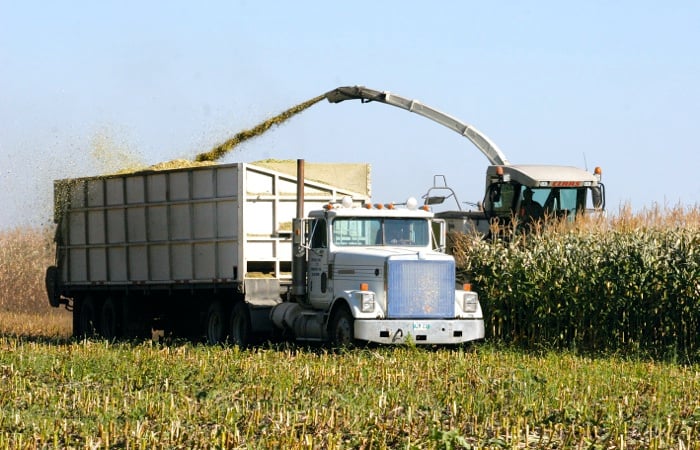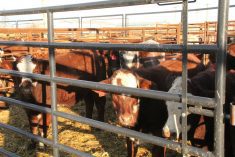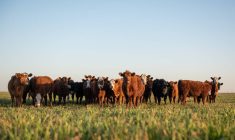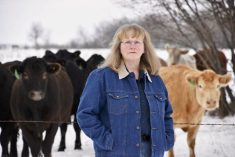Vets call it traumatic reticuloperitonitis, but it’s better known as “hardware disease,” a term referring to a medical condition caused when an object penetrates through the reticulum, or second stomach causing infection in the abdomen. If a sharp object goes through the diaphragm, the cow can die of heart failure.
Hardware disease drains production of a cow herd since penetration can also cause infection and abscesses with adhesions (scarring). This can lead to the cow losing weight and having intestinal problems. Diarrhea may result, or it appears to “walk on eggs” (humped back and stiff gait).
Read Also

Pig transport stress costs pork sector
Popular livestock trailer designs also increase pig stress during transportation, hitting at meat quality, animal welfare and farm profit, Agriculture and Agri-Food Canada researcher says
With advanced hardware disease there may be infection around the heart, and brisket edema resulting from the heart failure. When they reach this stage treatment is seldom successful. Occasionally the infection will damage or overstimulate the vagus nerve (this nerve is responsible for rumen contractions). If overstimulated the cow or bull may appear bloated.
Grunting from the pain is another common finding. Veterinarians often diagnose hardware by listening for a grunt with the stethoscope at the same time as doing a withers pinch.
Prevention is key
The key to this disease is prevention. A heavy exceptionally strong rumen magnet can sit in the reticulum. The magnets are a low-cost investment ($3-$5) and stay in the reticulum for the life of the cow or bull. As ruminal contractions push the feed past this area (all feed must pass this area), ferric-containing metal objects attach to the magnet. The digestive juices gradually degrade the metal pieces, so there is a continual transition of metal being attracted and degraded so the magnets never lose their effectiveness.
Modern farms use a lot of large equipment such as silage choppers and feed wagons that can be the source of metal. For instance, a silage cutter can pick up a chunk of wire in a swath and turn it into many sharp, bite-size pieces. Cattle are indiscriminate eaters. They do not sift through their feed the way some other species such as horses do. This is why we find things such as metal and twine balls in their stomachs.
It is a good idea that many equipment manufacturers already put large strong magnets on equipment such as feed wagons, silage choppers and blowers. It is amazing how much metal accumulates in these areas after only a few days of use. These magnets should be cleaned weekly to allow new pieces to be attracted. Unfortunately, these magnets do not protect cows on pasture or eating baled hay. Magnets or metal detectors are also used in commercial feed mills.
If you have ever had cows doing poorly, hardware disease is a possibility. A magnet can easily be administered. Insert the magnet into the animal’s mouth with a plastic or aluminum balling gun and wait to be sure it is swallowed.
Routine with dairy cows
In our practice, almost all dairy cows have magnets inserted when they enter the breeding herd. Purebred breeders put a lot of value on their stock and should consider magnets. It may be wise for purebred breeders and commercial producers to put them in valuable breeding bulls or if hardware has been a problem give all breeding-age heifers a magnet. They stay in for the life of the animal so are a small investment for a long-term gain.

Magnets can often be purchased in bulk for a reduced price. Several brands are on the market and generally speaking the better the quality (strength), the higher the price (most are less than $4). Test them before use — coins, nails etc. should be very hard to pull off. If they aren’t, the magnet isn’t strong enough. Two magnets are no improvement because they will attach to one another, perhaps increasing the surface area to attach to but that is all.
If an animal requires a post-mortem, the vet can retrieve the magnet for use in another animal. It also provides useful evidence of the metal sources to your operation. I have seen these magnets attract such things as fencing staples, chain links, grease nipples, wire nails, screws… the list goes on and on. Unfortunately the magnets will not attract aluminum and some other metals used in today’s modern farming practices.
Keep pastures clean
We must try and minimize exposure of cattle to metal objects by keeping pastures clean. Picking up wire fragments when fencing and keeping equipment in good repair all minimize the exposure our cattle have to picking up metal objects. Old deteriorating fences are a very common source of metal.
For every case of clinical hardware disease there are probably many subclinical cases where decreased production is the only real sign. In situations where you have one or more cases of clinical hardware yearly or if pasturing very metal-littered pastures, consider magnetizing every animal. This may be an investment well worth it. For sure valuable bulls and breeding stock should be routinely given magnets as yearlings when they enter the breeding herd. Place heavy magnets on feeding equipment and be sure and have your vet retrieve a magnet if doing a post-mortem. It can reveal much about how and what types of sharp metal objects your cattle are exposed to.




















